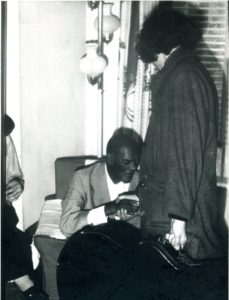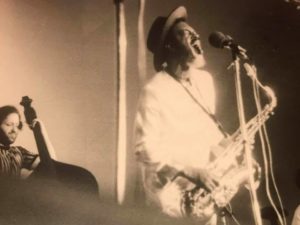
Annie (1895-1997) and the Rev. Gary Davis (1896-1972).
Eager to share what went down at our World of Music class comprised of first year students this morning at Mannes / New School University. After exploring African genres last week and how some elements survive in traditional American Blues & Gospel, we went deeper into the regions of Spiritual music.
No photo exists of Sister Cora Hopson, who left but one recording in 1926 of an Antebellum Sermon. The war in question was our own Civil War and as she has an aged voice, Hopson may have well been an ex-slave herself. In once moment she admonishes her listeners not to consider her comments applying to the present time, as her text focuses on Moses seeking freedom for his people, a necessary metaphor that conceals their need to be free and tear down the suppression, something that White overseers would interpret as harmless as it was pertaining to a biblical homily.
Then came the prolific Rev. J. M. Gates (1884-1945),

an early prolifically recorded preacher with congregants join him in singing I’ve Done Crossed the Separating Line, an incredible call to realize that one can transcend mundanity with all its grief and dangers for a higher region of existence that is ever-present.
As recordings spread to document our traditional music in the 1920s, groups that incorporated instruments with song were captured, such as Elders Lonnie MacIntorsh, Edwards, and Sisters Bessie Johnson & Melinda Taylor (no photos or dates, alas!) They cry out in The Latter Rain is Falling:
Their singing and playing reaches an extreme of the Baptist sect yet we find a more exuberant use of Jazz and instruments in the congregation of Rev. D.C. Rice (1888-1973)

who left the Baptists for Pentecostalists in Chicago who defied any music from being proscribed. A phenomenon, it drew the writer Zora Neale Hurston into their orb and I urged our class to explore her writings. There is even a trumpet solo that parallels Louis Armstrong’s rise and how Jazz was aboil in the 1920s:
While well-known hymns appeared in all genres and sects, individual artistry enters the picture through original texts and performances. Anne Graham, of whom we know little, composed for ensembles and once sang on Huddie Ledbetter (1888-1949) [Leadbelly]’s weekly New York radio show

in the early 1940s. Together they approach the theme of inner life mixed with the Biblical tale of Joshua in What Kind of Soul Hath Man:
Blind Willie Johnson (1897-1945)

was a sightless evangelical mystic who moaned out Dark Was the Night:
For the Rev. Gary Davis, I prefaced his life with a true tale of his 1970 tour in the U.K. A twenty-something John Dyer had heard a concert and was awestruck. Upon learning that Davis lived in Jamaica he immediately went up from Brighton to their embassy in London. No trace of Davis could be found until someone advised that he lived in Jamaica, Queens. Grabbing a bag and a one-way ticket he arrived at JFK International Airport and was left by a taxi at the Davis’s doorstep. Ringing the bell, Annie asked “Who are you?” to which Dyer replied that he had traveled from England just to study with the Reverend. Annie welcomed him in and John stayed for over half a year as their home was a caravansary for musicians and spreaders of the gospel.
Our class of first year students were amused and then surprised to learn that their teacher (1956-) was Davis’s last pupil,

cutting high school to grab a bus for lessons, worrying that I’d be nabbed as a truant. A stunning example of his artistry for Gospel music is his narration and singing of Crucifixion, a Dantesque mix of perception from Pontius Pilate and his wife’s words, a cut and dried repetition of quotes by disciples and a narrator who gazes onto their actions from a divine perspective.
I also advised them to notice how Davis usually does not sing a direct melody but combines voice and guitar to create the impression of its presence, one of his great musical achievements, not to overlook how the guitar’s subtle syncopations and ornaments are like the piano parts in Schubert’s Lieder.
One individual who used Gospel themes and marches was the saxophonist and composer Albert Ayler (1936-1970). How would the students react to hearing free jazz, from almost half a century ago, accustomed as they are to melody and it’s base for improvisations as composed variation? At one of his last concerts, held at the Fondation Maeght in Saint-Paul de Vence in 1970, a photo taken at the concert shows him with bass player Steve Tintweiss who has always been active in music since then and earlier. The entire concert was filmed but remained inaccessible due to uncertain reasons . . .

The Truth is Marching In has a floating opening that leads into the march, flits back into a different space and then is propelled into a spiritual ecstasy:
Some class members stated that the melodic parts were fine with them but the solo was too much! One composer liked it. But how to show that it was quite the contrary to being an excursion away from Gospel traditions? We drew on the Rev. Frank Cotton’s sermon on Lazarus and Christ in The Pool of Siloam. As Ayler cannot be limited to standard pitches and has to transcend his instrument to enter into another dimension we hear it as a continuity of the Rev. Cotton lapsing from song and crescendos into a screaming that goes beyond words!
Our course is meant to uncover layers of cultural connections. Next week we will enter the earliest Blues artists and show how they created new music when migrating up from the Delta and Eastern seaboard by plugging in and astonishing with a new music that inspired outsiders to ravage them for their own worthy and exploitative styles.
©Allan Evans 2019
